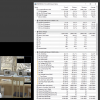Not gonna lie, if I had a 5950X burning 110W on a ~4c workload I would not really be complaining much, especially since I know the chip can't pull more than 32W on top of that as the workload intensifies (assuming I'm running stock).
I would not mind either, if they had anything to show for it. According to Anandtech testing, at 4c load they are achieving 4.725Ghz at the cost of 20W per core and 110W total.
While with undervolt and fixed OC i am achieving 4.4Ghz at the cost of 5.5W per core and 55W total. All cause of AMD marketing department deciding it is OK to shove 1.5V into the chip and hit as high freqs as possible.
Btw 5.5*16 => 88W, so ~ 120W of peak power usage when all cores are active.
AMD has incredible chips in 3950x and 5950x. Just that if left to default behavior they have atrocious power usage when left to the mercy of stock algorithms. The trade off seems to be 15W per core for maybe 5% more performance @stock.
Combine such nasty power usage with overhead of IOD and you end up with CPU, that competes with Intel's "finest" in burning power and only become efficienty in throughput/power mid-late in load regime.
Of course i understand AMD's position, more Mhz is good for marketing, and they need high voltages to have enough safety margin to account for load transients, frequency ramp from power saving, users running 16C on that motherboard with 2 phase VRM and so on. + my stability is without HT and probably would not hold Prime testing. Would it burn 15W more per core for 4.4? Nope.
I am running 3950X @4.05Ghz since last February, now 5950x joined compute resources @4.4ghz, very happy with these CPUs. Not happy with their brain dead hunt for mhz way out of efficient region.






